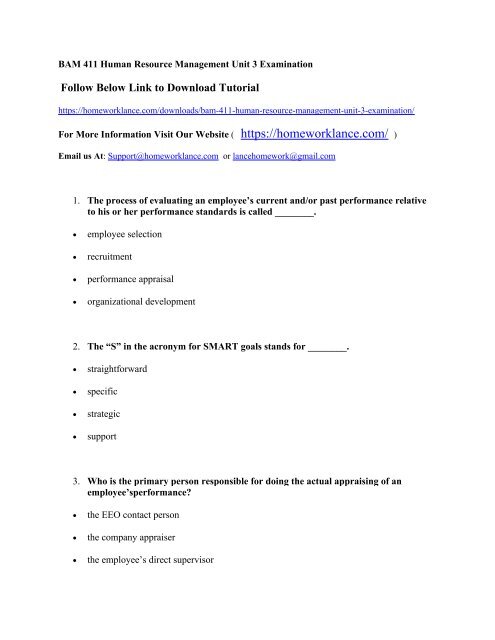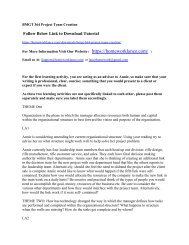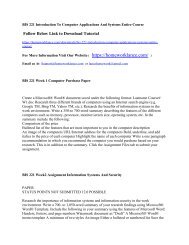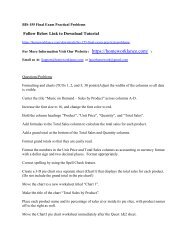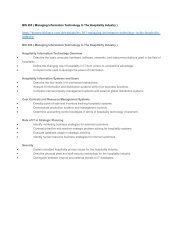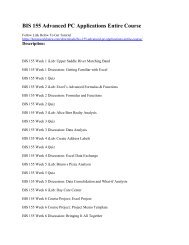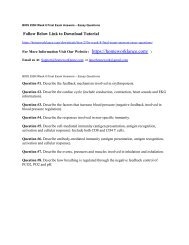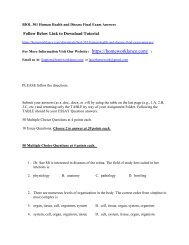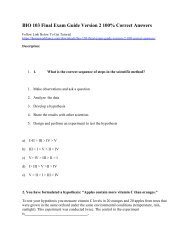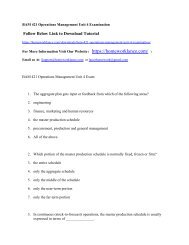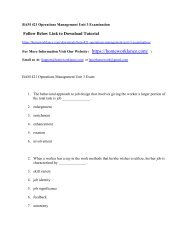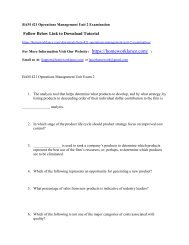BAM 411 Human Resource Management Unit 3 Examination
BAM 411 Human Resource Management Unit 3 Examination
BAM 411 Human Resource Management Unit 3 Examination
You also want an ePaper? Increase the reach of your titles
YUMPU automatically turns print PDFs into web optimized ePapers that Google loves.
<strong>BAM</strong> <strong>411</strong> <strong>Human</strong> <strong>Resource</strong> <strong>Management</strong> <strong>Unit</strong> 3 <strong>Examination</strong><br />
Follow Below Link to Download Tutorial<br />
https://homeworklance.com/downloads/bam-<strong>411</strong>-human-resource-management-unit-3-examination/<br />
For More Information Visit Our Website ( https://homeworklance.com/ )<br />
Email us At: Support@homeworklance.com or lancehomework@gmail.com<br />
1. The process of evaluating an employee’s current and/or past performance relative<br />
to his or her performance standards is called ________.<br />
<br />
<br />
<br />
<br />
employee selection<br />
recruitment<br />
performance appraisal<br />
organizational development<br />
2. The “S” in the acronym for SMART goals stands for ________.<br />
<br />
<br />
<br />
<br />
straightforward<br />
specific<br />
strategic<br />
support<br />
3. Who is the primary person responsible for doing the actual appraising of an<br />
employee’sperformance?<br />
<br />
<br />
<br />
the EEO contact person<br />
the company appraiser<br />
the employee’s direct supervisor
None of the above.<br />
4. Because in most organizations there is a hierarchy of goals, employee performance<br />
standardsshould ________.<br />
<br />
<br />
<br />
<br />
make sense in terms of the broader organizational goals<br />
be standard<br />
be decided by the top executive<br />
All of the above.<br />
5. Besides the supervisor, which of the following is available to managers as an<br />
alternative sourceof performance appraisal information?<br />
<br />
<br />
<br />
<br />
the employee<br />
rating committees<br />
peers<br />
All of the above.<br />
6. Suppose you have five employees to rate. You make a chart of all possible pairs of<br />
employees for each trait being evaluate Then, you indicate the better employee of<br />
the pair for each pair. Finally, you add up the number of positives for each<br />
employee. In this case, you have used the________ method of performance<br />
appraisal.<br />
<br />
<br />
<br />
<br />
forced distribution<br />
alternation ranking<br />
paired comparison<br />
graphic ranking scale
7. To protect against bias claims when using the forced distribution method, employers<br />
should<br />
________.<br />
<br />
<br />
<br />
<br />
train raters to be objective<br />
appoint a review committee to review any employee’s low ranking<br />
consider using multiple raters in conjunction with the method<br />
All of the above.<br />
8. All of the following are advantages of using the critical incident method for<br />
appraisingperformance except that:<br />
<br />
<br />
<br />
<br />
incidents can be tied to performance goals.<br />
it does not include a numerical rating.<br />
it provides examples of good performance.<br />
it provides examples of poor performance.<br />
9. What is the fourth step in the <strong>Management</strong> by Objectives Method?<br />
<br />
<br />
<br />
<br />
set the organization’s goals<br />
set departmental goals<br />
discuss departmental goals<br />
define expected results<br />
10. One personality study focused on how individual traits influenced the evaluations<br />
that studentsgave their peers. Raters who scored higher on ________ tended to give<br />
their peers lowerratings.
openness<br />
agreeableness<br />
conscientiousness<br />
extroversion<br />
11. One way of reducing the problems of leniency or strictness in performance<br />
appraisals is to________.<br />
<br />
<br />
<br />
<br />
consider the purpose of the appraisal<br />
be aware of the problem<br />
train supervisors to avoid it<br />
rank employees<br />
12. When an employee’s personal characteristics, such as gender, influence a<br />
supervisor’sevaluation of his or her performance, the problem of ________ has<br />
occurred.<br />
<br />
<br />
<br />
<br />
stereotyping<br />
halo affect<br />
central tendency<br />
bias<br />
13. When subordinates provide feedback for supervisors, the comments should be<br />
anonymousbecause identifiable responses tend to result in more ________.<br />
<br />
<br />
<br />
critical ratings<br />
inflated ratings<br />
negative attitudes from managers receiving the feedback
All of the above.<br />
14. The process through which someone becomes aware of personal skills, interests,<br />
knowledge, motivations; acquires information about opportunities; identifies career<br />
goals; and establishesaction plans to attain those goals is called ________.<br />
<br />
<br />
<br />
<br />
career management<br />
career development<br />
career planning<br />
organizational development<br />
15. Responsibility for career development should always be left to the ________.<br />
<br />
<br />
<br />
<br />
employee<br />
manager<br />
career success team<br />
supervisor<br />
16. What is another term for 360-degree feedback?<br />
<br />
<br />
<br />
<br />
multi-source feedback<br />
upward feedback<br />
wheel feedback<br />
feedback loop<br />
17. Direct financial payments include all of the following except:<br />
<br />
insurance
salaries<br />
incentives<br />
wages<br />
18. Which of the following is addressed by the Fair Labor Standards Act?<br />
<br />
<br />
<br />
<br />
child labor<br />
minimum wage<br />
maximum hours<br />
All of the above.<br />
19. According to the Fair Labor Standards Act, if a worker covered by the act works<br />
more than 40hours, he or she will receive overtime pay at a rate of ________ of<br />
normal pay for any hoursworked over 40 in a workweek.<br />
150%<br />
50%<br />
125%<br />
100%<br />
20. Which of the following occupations is exempt from overtime and minimum pay<br />
provisionsstated in the Fair Labor Standards Act?<br />
<br />
<br />
<br />
<br />
hourly cashiers<br />
data entry<br />
department heads<br />
none of the above
21. Under which condition is it acceptable for employees of the opposite sex to receive<br />
differentpay for doing roughly equivalent work?<br />
<br />
<br />
<br />
<br />
it is never acceptable<br />
when the difference exists because of a merit system<br />
when the difference exists despite similar responsibility<br />
when the difference exists despite equal skills<br />
22. The ________ prohibits discriminating against employees who are 40 years of age<br />
and older inall aspects of employment, including compensation.<br />
<br />
<br />
<br />
<br />
Civil Rights Act<br />
Fair Labor Standards Act<br />
Equal Pay Act<br />
Age Discrimination in Employment Act<br />
23. The ________ allows a firm to borrow against employee stock held in trust.<br />
<br />
<br />
<br />
<br />
Employer Retirement Income Security Act<br />
Fair Labor Standards Act<br />
National Labor Relations Act<br />
Civil Rights Act<br />
24. A ________ is comprised of jobs of approximately equal difficulty or importance as<br />
establishedby job evaluation.<br />
<br />
<br />
<br />
class<br />
pay grade<br />
benchmark
pay group<br />
25. Which health benefit listed below is offered by almost all employers?<br />
<br />
<br />
<br />
<br />
wellness program<br />
chiropractic insurance<br />
medical care insurance<br />
mental health insurance


